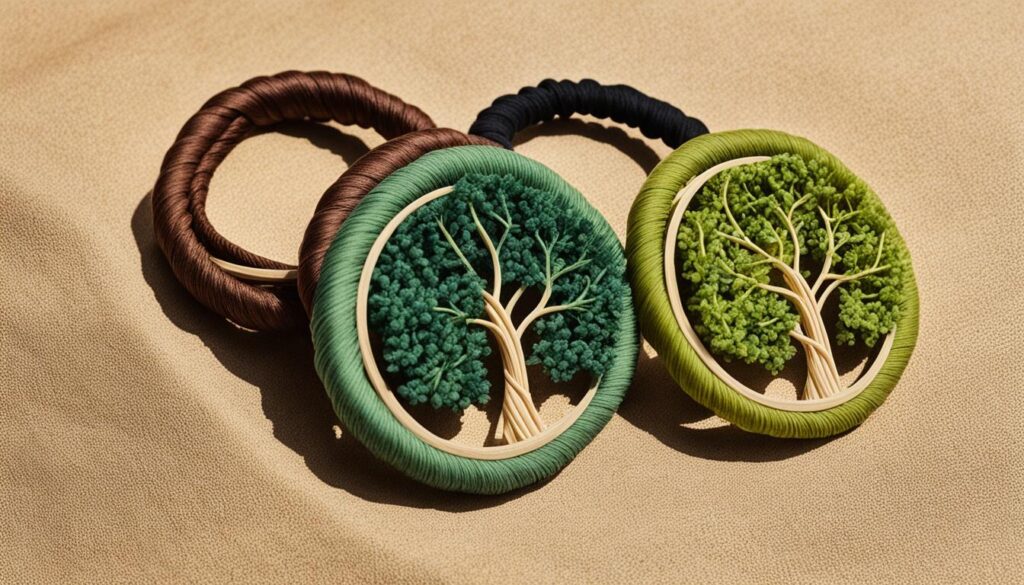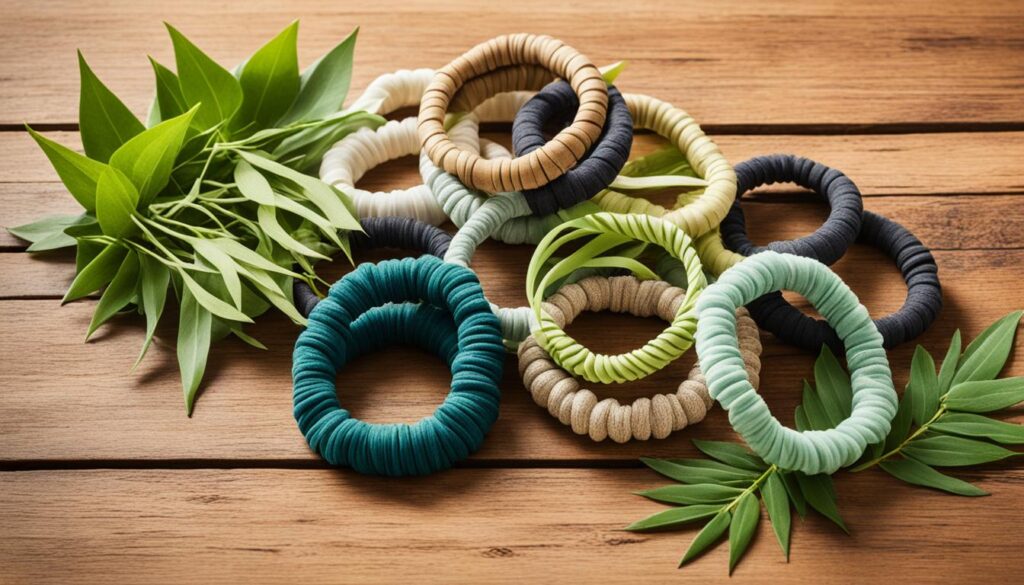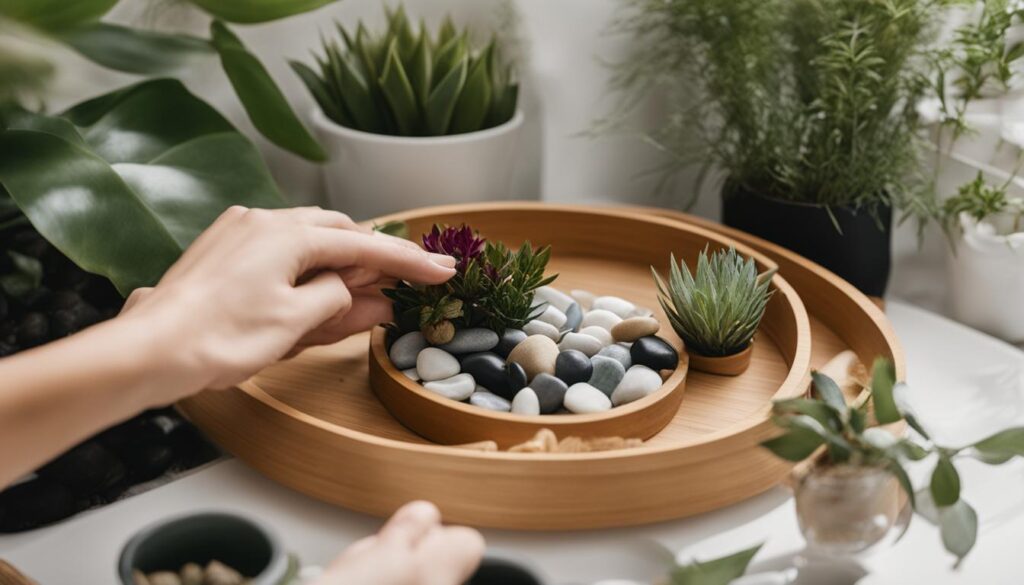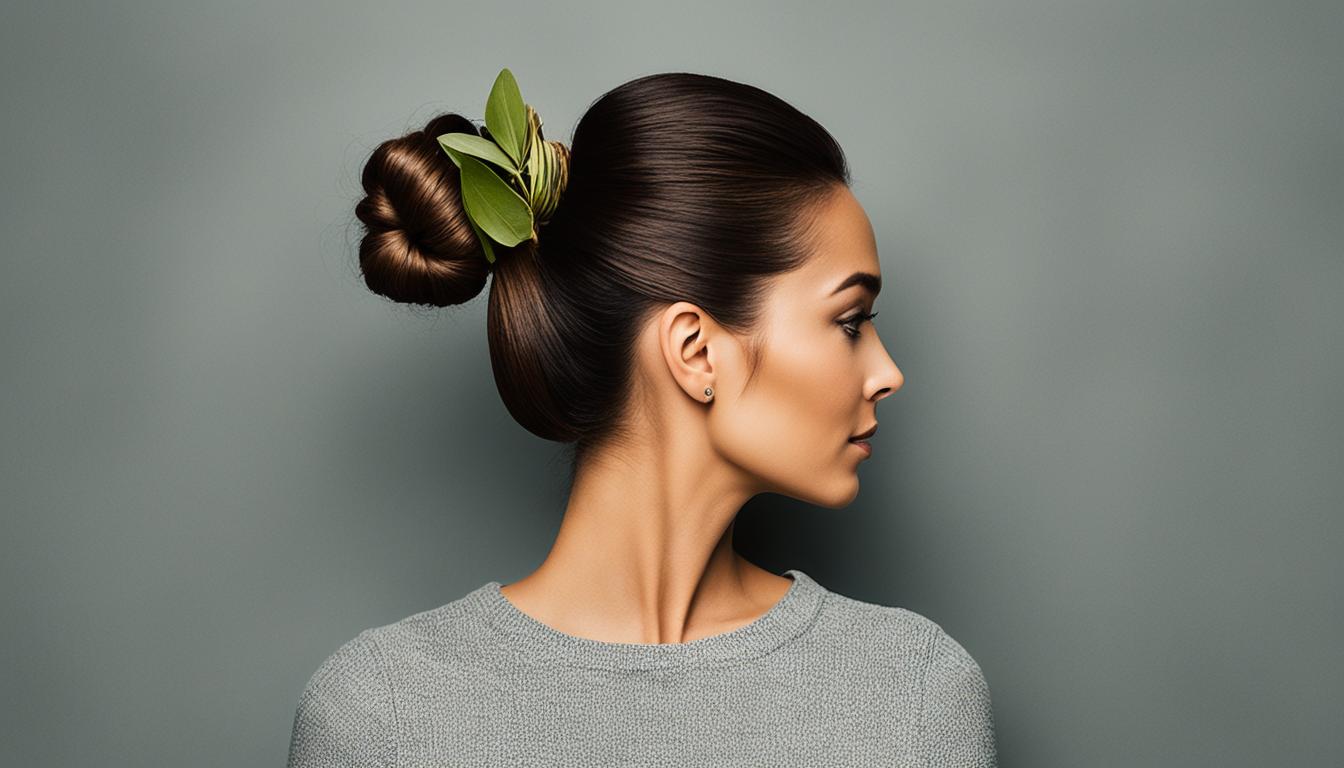Are you looking for a way to embrace sustainability and reduce your environmental impact? Look no further than plastic-free hair ties! By creating your own earth-friendly hair accessories, you can contribute to a greener lifestyle while still enjoying stylish and functional hair accessories.
Conventional hair ties made from synthetic materials are not only non-recyclable, but also contribute to waste production and environmental pollution. Plastic-free hair ties, on the other hand, are made from biodegradable materials such as organic cotton and natural rubber. These eco-friendly alternatives can be safely returned to the soil, reducing the amount of plastic waste in landfills and oceans.
There are several brands that specialize in sustainable and plastic-free hair ties. Kooshoo, Terra Ties, Tentree, Pamper Dreams, and FLON are just a few of the many options available. These brands prioritize using organic and natural materials, ensuring that their hair accessories are both stylish and environmentally-friendly.
Key Takeaways:
- Plastic-free hair ties are a great way to reduce plastic waste and embrace a greener lifestyle.
- Conventional hair ties made from synthetic materials are not recyclable and contribute to environmental pollution.
- Plastic-free hair ties are made from biodegradable materials like organic cotton and natural rubber.
- Brands like Kooshoo, Terra Ties, Tentree, Pamper Dreams, and FLON offer stylish and sustainable hair accessory options.
- By choosing plastic-free hair ties, you can make a positive impact on the environment and enjoy eco-friendly hair accessories.
The Problem with Conventional Hair Ties
When it comes to our daily hair routines, we often overlook the environmental impact of our accessories. Most conventional hair ties may seem harmless, but they are actually contributing to a much bigger problem.
These hair ties are typically made from synthetic materials, such as nylon or polyester. While these materials may be cheap and durable, they come with serious consequences for the environment. The non-recyclable nature of these synthetic materials means that once they are discarded, they end up in landfills, adding to the growing waste production.
Moreover, the decomposition process of these synthetic materials can take hundreds of years, if not more. This means that the hair tie you wore yesterday will still be sitting in a landfill long after you’re gone. Imagine the countless hair ties that end up in landfills each day, contributing to the ever-growing waste crisis.
“The environmental pollution caused by conventional hair ties is a serious issue that is often overlooked. Their non-recyclable nature and slow decomposition process make them a significant contributor to waste production.” – Environmental expert
It’s not just the waste production that is concerning. The production of synthetic materials used in these hair ties also has a negative impact on the environment. The manufacturing process involves the release of harmful substances and pollutants into the air and water, contributing to air pollution and water contamination. This, in turn, affects ecosystems and poses a threat to marine life.
The Environmental Impact of Conventional Hair Ties:
| Issue | Impact |
|---|---|
| Non-recyclable materials | Contributes to waste production |
| Slow decomposition | Takes years to decompose in landfills |
| Release of harmful substances | Contributes to air and water pollution |
| Threat to marine life | Contaminates water bodies and ecosystems |
With the increasing awareness of sustainability and the need to reduce waste, it’s clear that conventional hair ties are not the way to go. Thankfully, there are alternatives available that offer a more eco-friendly choice.
The Benefits of Plastic-Free Hair Ties
Plastic-free hair ties offer a multitude of benefits that make them a popular choice for eco-conscious individuals. These hair accessories are crafted from biodegradable materials, such as organic cotton and natural rubber, making them a sustainable and environmentally-friendly alternative. Unlike conventional hair ties made from synthetic materials, plastic-free hair ties can be safely returned to the soil without causing harm to the environment.
Not only are plastic-free hair ties biodegradable, but they also boast a range of advantages over their synthetic counterparts. These hair ties are gentle on hair, minimizing tangling, breakage, and damage. Their durability ensures that they can withstand daily use without losing their elasticity, providing lasting hold for various hairstyles. Moreover, plastic-free hair ties come in a wide array of colors and styles, allowing you to express your personal style while making an eco-friendly choice.
By opting for plastic-free hair ties, you are supporting the use of organic and natural materials in your beauty routine. This reduces the demand for synthetic and non-recyclable materials, contributing to a cleaner and greener planet. Additionally, the use of biodegradable materials helps to minimize waste production, as these hair ties can naturally decompose over time, leaving no harmful residues behind.

If you care about the environment and strive for a more sustainable lifestyle, incorporating plastic-free hair ties into your daily routine is a small but impactful step. Not only will you enjoy the benefits of gentle, durable, and stylish hair accessories, but you’ll also be reducing your carbon footprint and actively contributing to a healthier planet.
Sustainable Brands for Plastic-Free Hair Ties
When it comes to finding sustainable alternatives to conventional hair ties, there are several brands that stand out for their commitment to producing plastic-free options. These brands prioritize using organic and natural materials to create stylish and environmentally-friendly hair accessories. Let’s take a closer look at some of the top choices:
Kooshoo
“At Kooshoo, we believe in creating beautiful products while minimizing our impact on the planet. Our plastic-free hair ties are made with organic cotton and natural rubber, offering a sustainable and comfortable option for your hair needs.”
Terra Ties
“Terra Ties is dedicated to reducing plastic waste by offering biodegradable hair ties. Our all-natural hair ties are made from organic cotton and natural rubber, ensuring a strong hold without harming the environment.”
Tentree
“Tentree’s commitment to sustainability extends to their hair accessories. Their plastic-free hair ties are crafted from organic cotton and recycled materials, allowing you to style your hair with a clear conscience.”
Pamper Dreams
“Pamper Dreams believes that self-care should not come at the expense of the planet. Their plastic-free hair ties are made with organic bamboo and natural rubber, providing a gentle and eco-friendly solution for all hair types.”
FLON
“FLON is dedicated to creating sustainable accessories that elevate your style. Their plastic-free hair ties are made from organic cotton and natural rubber, ensuring both fashion and eco-consciousness in every hairstyle.”
These brands offer a range of options, from classic colors to fun patterns, allowing you to express your personal style while making a positive impact on the environment. By choosing plastic-free hair ties from Kooshoo, Terra Ties, Tentree, Pamper Dreams, or FLON, you can confidently embrace eco-friendly hair accessories.

Stay tuned for the next section which explores alternative options to plastic-free hair ties!
Alternatives to Plastic-Free Hair Ties
While plastic-free hair ties are a fantastic eco-friendly option, there are also several other alternatives available that can help you reduce plastic waste and achieve stunning hairstyles. Here are some creative alternatives to consider:
Ribbons
Ribbons are a versatile and stylish alternative to hair ties. They come in various colors, patterns, and textures, allowing you to add a touch of elegance to your hair while keeping it in place. Simply tie a ribbon around your ponytail, braid, or bun to create a chic and sustainable look.
Hair Bands
Hair bands are another popular choice for those seeking an alternative to plastic hair ties. Made from different materials such as cloth, elastic, or natural fibers, hair bands offer a secure hold and come in various sizes to accommodate different hair thicknesses.
Bandanas
Bandanas not only add charm to your hairstyle but can also serve as a functional accessory. You can tie a bandana around your head to keep your hair away from your face, or create a trendy turban-style look. The wide variety of colors and patterns available ensures you can find one that suits your personal style.
Bobby Pins
Bobby pins are a classic hair accessory that can be used in a multitude of styles. They are perfect for securing small sections of hair or creating intricate updos. Bobby pins come in various sizes and designs, making them both practical and fashionable.
Hair Clips
Hair clips are a versatile alternative to hair ties. They can be used to hold hair in place, add decorative accents, or create intricate hairstyles. Hair clips come in a wide range of styles, from minimalist designs to bold and statement-making pieces, allowing you to express your unique style.
Chopsticks
For those with long or thick hair, chopsticks can be an excellent alternative to hair ties. By twisting your hair into a bun or knot and securing it with chopsticks, you can achieve an elegant and sophisticated hairstyle while reducing the need for disposable hair ties.
Pencils
Believe it or not, pencils can also be used as a temporary alternative to hair ties. Simply twist your hair into a bun and secure it with a pencil for a quick and easy hairstyle. Just make sure to choose a clean pencil without a sharp tip to avoid any discomfort.
By embracing these alternatives to plastic-free hair ties such as ribbons, hair bands, bandanas, bobby pins, hair clips, chopsticks, and even pencils, you can add variety to your hairstyles while making a positive impact on the environment. Experiment with different options and let your creativity shine!
Extending the Life of Hair Ties
To ensure that your plastic-free hair ties last as long as possible, it is essential to provide them with proper care. By following a few simple steps, you can maximize their longevity and contribute to a more sustainable lifestyle.
Proper Care Tips for Hair Ties:
- Avoid Sun Exposure: Sunlight can weaken the elasticity of hair ties, causing them to lose their shape and effectiveness. Keep your hair ties away from direct sunlight, such as by storing them in a drawer or container.
- Wash with Like Colors: When it’s time to clean your hair ties, it’s important to wash them with like colors. This prevents color bleeding and ensures that your hair ties maintain their vibrant appearance. Use cold water and a gentle detergent to wash them by hand or in a lingerie bag.
- Remove Oils and Hair Products: Over time, hair ties can accumulate oils and hair products, which can affect their elasticity and overall performance. To keep them in optimal condition, remove any excess oil or residue by gently washing them with mild soap and water. Allow them to air dry completely before using them again.
By adopting these proper care practices, you can prolong the lifespan of your plastic-free hair ties and reduce the need for frequent replacements. This not only saves you money but also minimizes waste and supports a more sustainable approach to hair accessory consumption.

Testimonial:
“I used to go through hair ties so quickly, constantly having to buy new ones. But ever since I started taking better care of them, they last so much longer. It’s a small change that makes a big difference in reducing waste!”
– Emily
| Common Hair Tie Care Mistakes | Proper Care Tips |
|---|---|
| Leaving hair ties exposed to sunlight | Avoid sun exposure by storing them in a cool place |
| Washing hair ties with other clothing items | Wash hair ties with like colors in cold water |
| Ignoring oil and product buildup | Regularly clean hair ties with mild soap and water to remove residue |
| Using excessive heat to dry hair ties | Air dry hair ties to maintain their elasticity |
Ethical and Sustainable Practices
When it comes to plastic-free hair ties, ethical and sustainable practices are at the forefront for many brands. These companies are committed to producing hair accessories that prioritize the well-being of the planet and its inhabitants.
One of the key aspects of ethical and sustainable practices is the use of Fair Trade materials. Brands that adhere to Fair Trade principles ensure that their products are sourced from producers who receive fair compensation for their labor and work in safe and empowering conditions. By supporting Fair Trade, you can contribute to a more equitable and just global marketplace.
In addition to Fair Trade, many brands also prioritize low impact dyes in the production of their hair ties. These dyes are formulated using environmentally friendly processes that minimize water usage and reduce the release of harmful chemicals into ecosystems. By choosing hair ties made with low impact dyes, you can minimize your carbon footprint and support sustainable manufacturing practices.
Sustainable sourcing is another important factor in the production of plastic-free hair ties. Brands that prioritize sustainable sourcing ensure that their materials are obtained in a manner that minimizes negative impacts on the environment. This includes using organic and natural materials, reducing waste in the production process, and implementing responsible resource management practices.
“Our commitment to ethical and sustainable practices drives everything we do. From sourcing the finest organic cotton for our hair ties to partnering with Fair Trade producers, we believe in creating accessories that are as beautiful as they are eco-conscious.” – Sarah Thompson, Founder of EarthScape Accessories
By supporting brands that prioritize ethical and sustainable practices, you can make a positive impact on the environment while enjoying stylish and eco-friendly hair accessories. With Fair Trade materials, low impact dyes, and sustainable sourcing, these brands are leading the way towards a greener future.
| Benefits of Ethical and Sustainable Practices: |
|---|
| 1. Reduced environmental impact |
| 2. Support for Fair Trade principles |
| 3. Minimization of harmful chemicals |
| 4. Conservation of natural resources |
| 5. Promotion of responsible manufacturing |

Environmental Impact of Hair Ties
Conventional hair ties have a significant environmental impact, contributing to landfill waste and marine pollution. The synthetic materials commonly used in these hair accessories release harmful substances into the environment during their production and disposal.
To illustrate the extent of this issue, data from various studies show that millions of hair ties end up in landfills each year, where they can take decades to decompose. Additionally, when these hair ties are discarded in water bodies, they contribute to marine pollution, endangering marine life and ecosystems.
Switching to plastic-free alternatives can help mitigate these negative impacts. By opting for hair ties made from biodegradable and eco-friendly materials such as organic cotton or natural rubber, we can reduce landfill waste and prevent the release of harmful substances into the environment.
Moreover, plastic-free hair ties offer a sustainable solution that aligns with our commitment to protecting the planet. These alternatives are not only better for the environment but also offer the same functionality and style as conventional hair ties.
| Environmental Impact of Hair Ties | Conventional Hair Ties | Plastic-Free Hair Ties |
|---|---|---|
| Contribution to landfill waste | High | Low |
| Release of harmful substances | Yes | No |
| Decomposition time | Decades | Biodegradable |
| Impact on marine life | High | Low |
In summary, making the switch to plastic-free hair ties not only allows us to reduce landfill waste and minimize marine pollution but also contributes to a greener and more sustainable future.
The Joy of Upcycling Hair Ties
When your plastic-free hair ties eventually wear out, there’s no need to throw them away. Instead, consider upcycling them and giving them a new purpose. One of the creative ways to reuse hair ties is by tying the ends together to create a loop. These loops can then be used to organize cords, such as charger cables, headphones, or any other tangled wires in your home or office.
Organizing cords with upcycled hair ties not only helps keep your space tidy but also contributes to reducing waste. By reusing hair ties in this way, you’ll be extending their lifespan and maximizing their usefulness. Plus, it’s a great way to declutter and save money by avoiding the need to buy specific cord organizers.
Upcycling hair ties to organize cords is both practical and eco-friendly. It’s a simple and cost-effective solution that adds a touch of creativity to your daily life.
Next time you have hair ties that are no longer suitable for your hair, give them a new purpose by repurposing them as cord organizers. It’s a small but impactful step towards a more sustainable lifestyle.
Benefits of Upcycling Hair Ties for Cord Organization:
- Reduces waste by giving hair ties a new purpose
- Organizes cords and prevents tangling
- Cost-effective alternative to purchasing cord organizers
- Encourages creativity and resourcefulness
- Contributes to a more sustainable lifestyle
Incorporating upcycled hair ties into your cord organization routine is a win-win situation. Not only will you have a practical solution for keeping cords neat and tidy, but you’ll also be making a positive impact on the environment by reducing waste.
An Example of Upcycling Hair Ties for Cord Organization:
Let’s say you have several hair ties that you no longer use. Instead of throwing them away, you can follow these simple steps to repurpose them:
- Gather the hair ties that you want to upcycle.
- Hold two hair ties together and tie the ends in a knot.
- Your upcycled hair tie cord organizer is ready to use!
The possibilities for upcycling hair ties are endless. Get creative and explore other ways to repurpose these versatile accessories in your daily life!
Finding Hair Ties in Unexpected Places
When it comes to eco-friendly choices, sometimes the best solution is the most simple one. Instead of buying new hair ties and contributing to waste production, consider picking up lost hair ties you come across on the street. Not only does this help reduce waste, but it also provides an eco-friendly alternative to purchasing new accessories.
Some may question the idea of grabbing hair ties off the ground, but with proper cleaning and disinfecting, they can be just as good as new. Before using them, simply wash the hair ties with warm soapy water and let them air dry. This ensures they are clean, hygienic, and ready to use.
By picking up hair ties, you are not only reducing waste but also making a small effort towards sustainability. You are giving these lost hair ties a second chance and preventing them from ending up in landfills or polluting our oceans.
This eco-friendly choice may also spark conversations about waste reduction among your friends, family, and colleagues. By sharing your actions and explaining the benefits of reusing hair ties, you can inspire others to make similar choices in their daily lives.
Make a Difference, One Hair Tie at a Time
Picking up hair ties is a simple yet impactful way to reduce waste and support a greener lifestyle. By reusing lost hair ties, we can make a positive contribution to the environment, one hair tie at a time.
Next time you see a hair tie on the ground, don’t hesitate to pick it up and give it a new purpose. Not only will you save money and reduce waste, but you’ll also be making a conscious choice that aligns with your eco-friendly values.
| Benefits of Picking Up Hair Ties | How It Contributes to a Greener Lifestyle |
|---|---|
| Reduces waste production | Prevents hair ties from ending up in landfills |
| Provides an eco-friendly alternative | Avoids the need to purchase new accessories |
| Encourages conversations about waste reduction | Inspires others to make sustainable choices |
By making conscious choices like picking up hair ties, we can all contribute to a more sustainable future. Every small action adds up, and together, we can make a significant impact in reducing waste and preserving our planet.
Conclusion
In conclusion, opting for sustainable hair accessories, such as plastic-free hair ties, is a simple yet impactful way to contribute to a greener lifestyle. By creating your own earth-friendly hair accessories or choosing eco-friendly brands, you can make a positive impact on the environment.
Plastic-free hair ties offer a sustainable alternative to conventional hair accessories that are typically made from non-recyclable synthetic materials. These alternatives are often made from biodegradable and organic materials like natural rubber and organic cotton, ensuring that they can safely return to the soil without contributing to waste production.
In addition to their environmental benefits, plastic-free hair ties are also gentle on hair and come in a wide range of colors and styles. By prioritizing sustainable hair accessories, you can take small steps towards reducing landfill waste, minimizing marine pollution, and avoiding the harmful substances released by synthetic materials.
Embracing sustainable hair accessories is not only a way to make a positive impact but also a way to inspire others to follow suit and adopt a greener lifestyle. By considering the materials used in our everyday accessories and making conscious choices, we can all contribute to a more sustainable future.
FAQ
Why should I switch to plastic-free hair ties?
Plastic-free hair ties are a sustainable choice that helps reduce environmental impact. They are made from biodegradable materials and can be safely returned to the soil.
Where can I find plastic-free hair ties?
There are several brands that specialize in sustainable and plastic-free hair ties. Some popular options include Kooshoo, Terra Ties, Tentree, Pamper Dreams, and FLON.
What are the alternatives to plastic-free hair ties?
You can choose from a variety of alternatives such as ribbons, hair bands, bandanas, bobby pins, hair clips, chopsticks, and pencils for your hair accessories.
How can I extend the life of my plastic-free hair ties?
To extend the life of your hair ties, avoid sun exposure, wash them with like colors in cold water, and remove oils and hair products.
Do brands that offer plastic-free hair ties follow ethical practices?
Many brands that offer plastic-free hair ties prioritize ethical and sustainable practices. This includes using Fair Trade materials, employing low impact dyes, and sourcing organic and sustainable materials.
How do conventional hair ties contribute to environmental pollution?
Conventional hair ties made from synthetic materials contribute to landfill waste and marine pollution. They release harmful substances into the environment during production and disposal.
What can I do with old hair ties?
You can upcycle your old hair ties by tying the ends together and using them to organize cords or for other purposes. This gives them a new lease on life and helps reduce waste.
Is there an eco-friendly alternative to buying new hair ties?
Instead of buying new hair ties, consider picking up lost hair ties you come across on the street. This reduces waste and provides an eco-friendly alternative to purchasing new accessories.

